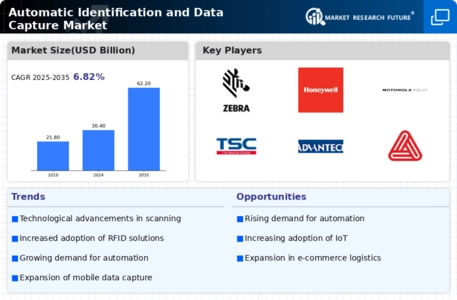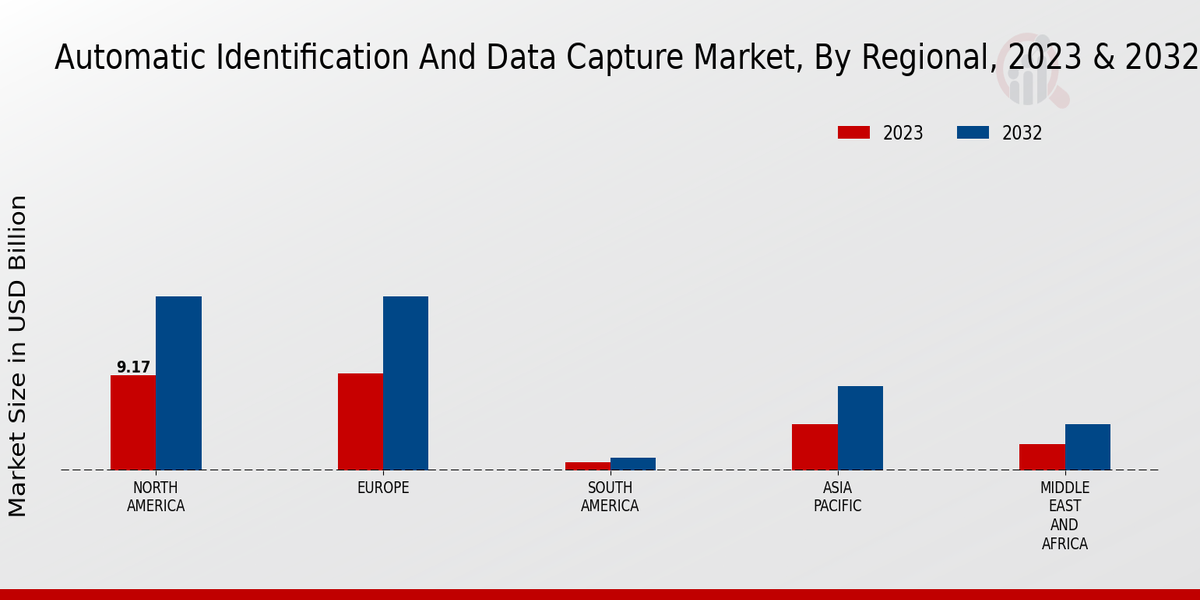Growth of E-commerce
The rapid growth of e-commerce is significantly influencing the Global Automatic Identification and Data Capture Market Industry. As online shopping continues to expand, businesses are adopting advanced data capture solutions to manage inventory and streamline logistics. For example, major e-commerce platforms are implementing barcode scanning and RFID systems to enhance order fulfillment processes. This shift not only improves customer satisfaction but also optimizes supply chain operations. The increasing reliance on efficient data capture methods in e-commerce is expected to drive market growth, aligning with the projected CAGR of 6.74% from 2025 to 2035.
Market Growth Projections
The Global Automatic Identification and Data Capture Market Industry is projected to witness substantial growth over the next decade. With a market value of 30.4 USD Billion in 2024, it is anticipated to reach 62.2 USD Billion by 2035. This growth trajectory suggests a robust compound annual growth rate (CAGR) of 6.74% from 2025 to 2035. Such projections indicate a strong demand for automatic identification technologies across various sectors, driven by the need for improved efficiency, accuracy, and compliance. The market's expansion reflects the increasing reliance on data capture solutions in a rapidly evolving technological landscape.
Technological Advancements
The Global Automatic Identification and Data Capture Market Industry is experiencing rapid technological advancements that enhance operational efficiency. Innovations in barcode scanning, RFID technology, and biometric systems are driving this growth. For instance, RFID technology has improved inventory management, allowing businesses to track assets in real-time. This is particularly relevant in sectors such as retail and logistics, where accuracy and speed are paramount. As a result, the market is projected to reach 30.4 USD Billion in 2024, reflecting a growing reliance on these technologies to streamline processes and reduce errors.
Increased Demand for Automation
There is a notable increase in demand for automation across various industries, which is propelling the Global Automatic Identification and Data Capture Market Industry. Companies are increasingly adopting automated solutions to enhance productivity and reduce labor costs. For example, manufacturing firms are utilizing automated data capture systems to monitor production lines, leading to improved efficiency and reduced downtime. This trend is expected to contribute to the market's growth, with projections indicating a rise to 62.2 USD Billion by 2035. The shift towards automation suggests a long-term commitment to integrating advanced data capture technologies.
Integration of IoT Technologies
The integration of Internet of Things (IoT) technologies is transforming the Global Automatic Identification and Data Capture Market Industry. IoT devices facilitate real-time data collection and analysis, enabling businesses to make informed decisions. For instance, smart sensors in logistics can track shipments and monitor conditions, providing valuable insights into supply chain performance. This technological synergy enhances operational efficiency and reduces costs, making it an attractive option for various sectors. As IoT adoption continues to rise, the market is poised for substantial growth, driven by the demand for interconnected data capture solutions.
Regulatory Compliance and Standards
Regulatory compliance is a critical driver for the Global Automatic Identification and Data Capture Market Industry. Industries such as healthcare and food safety are subject to stringent regulations that necessitate accurate data capture and tracking. For instance, the FDA mandates that pharmaceutical companies implement traceability systems to ensure product safety. This regulatory landscape compels organizations to invest in automatic identification technologies to maintain compliance and avoid penalties. As a result, the market is likely to see sustained growth, as adherence to regulations becomes increasingly vital for operational success.













